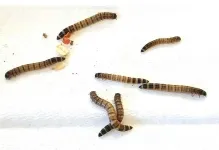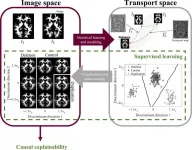(Press-News.org) Girls with mental illness or neurodevelopmental conditions are less likely than their peers to be vaccinated with the HPV vaccine that protects against future cervical cancer. This is according to a new registry study from Karolinska Institutet in Sweden published in The Lancet Public Health.
The study involved more than 115,000 girls covered by the Swedish school-based human papillomavirus (HPV) vaccination programme. The vaccine, which prevents cervical cancer, among other things, is offered to all children in Sweden and given by school health services.
Significant differences
The researchers found significant differences when examining the association between vaccination coverage and psychiatric diagnoses or the use of psychotropic medications.
Girls with psychiatric diagnoses had an 11 per cent lower vaccination coverage of the first dose of the HPV vaccine compared to girls of the same age without such diagnoses. The difference was particularly pronounced among girls with autism or intellectual disability, who had over 20 per cent lower vaccination coverage.
Girls who received medication for mental health conditions had a 7 per cent lower vaccination coverage, but the figures varied significantly depending on the type of medication prescribed. Among girls receiving antipsychotic medication, vaccination coverage was as much as 32 per cent lower compared to girls of the same age without such medication.
Ensuring health equity
“Our study emphasises the need for targeted interventions to ensure equitable healthcare for all children,” says Kejia Hu, postdoctoral researcher at the Institute of Environmental Medicine, Karolinska Institutet. “All girls should have equal access to life-saving vaccines regardless of their mental health status.”
In contrast, girls with psychiatric diagnoses or mental illness who received the first dose of vaccine were as likely as their peers to receive the second dose of vaccine, which is given within one year of the first dose. In addition, parental mental health conditions did not significantly impact vaccination coverage in their daughters.
Find the underlying causes
“More research is needed to find out the underlying reasons why fewer girls with mental illness or neuropsychiatric conditions are vaccinated against HPV so that we can tackle this challenge,” says Karin Sundström, senior researcher at the Center for Cervical Cancer Elimination at the Department of Clinical Science, Intervention and Technology, Karolinska Institutet.
The study was mainly funded by the Swedish Cancer Society. Karin Sundström has received research grants, consultancy fees, payment for presentations and travel support from the pharmaceutical company Merck. Two other co-authors have received research funding from pharmaceutical companies. See the scientific article for a complete list of potential conflicts of interest.
Publication: “The role of mental illness and neurodevelopmental conditions in human papillomavirus vaccination uptake within the Swedish school-based vaccination programme: a population-based, cohort study”, Kejia Hu, Mary M Barker, Eva Herweijer, Jiangrong Wang, Adina L Feldman, Donghao Lu, Unnur Valdimarsdóttir, Karin Sundström, Fang Fang, The Lancet Public Health, online 28 August 2024.
END
Lower HPV vaccination coverage among girls with mental health conditions
2024-08-29
ELSE PRESS RELEASES FROM THIS DATE:
Scientists discover how the body's killer cells attack cancer
2024-08-29
Scientists are on the verge of a cancer breakthrough after working out how the body’s immune system targets cells devastated by the disease.
A new study has discovered that our natural killer cells, from the immune system which protect against disease and infections, instinctively recognise and attack a protein that drives cancer growth.
The experts say that by hijacking this protein, known as XPO1, they may be able to activate more killer cells to destroy the disease.
Scientists from the University of Southampton, working with experts worldwide, led the study and now believe it could offer new ...
Interprofessional training in health sciences education has a lasting impact on practice
2024-08-29
Geriatrics experts have long known that collaboration is key to delivering quality, patient-centered care to older adults.
That’s why USC’s Interprofessional Education and Collaboration for Geriatrics (IECG) trains up to 150 students annually from seven health professions to teach the importance of teamwork in meeting the complex needs of the elderly.
Now, a study published in the Journal of Interprofessional Care highlights the long-term impact of IECG on USC health sciences graduates.
Researchers surveyed graduates one to three years after completing IECG to assess how the program influenced their practice. The findings were significant: 81% ...
Study reveals molecular mechanism behind MS and other autoimmune diseases
2024-08-28
New Haven, Conn. — More than two decades ago, a research team in the lab of David Hafler, a Yale researcher who at the time was at Harvard, discovered a type of T cell in humans that suppresses the immune system; they later found that these so-called regulatory T cells, when defective, are an underlying cause of autoimmune disease, specifically multiple sclerosis (MS). For many years, however, the mechanism behind this dysfunction has remained unclear.
In a new Yale-led study, a team of researchers finds that this loss of immune regulation is triggered by an increase in PRDM1-S, a protein involved in immune function, ...
To build a thriving electric vehicle market, prioritize equity and justice
2024-08-28
When it comes to purchasing and using electric vehicles (EVs), housing- and income-related factors significantly shape perceptions and preferences among potential buyers, finds a new study in Energy and Climate Change. This research, a collaboration between the Boston University Institute for Global Sustainability (IGS) and the U.S. Department of Energy’s National Renewable Energy Laboratory (NREL), is among the first to examine both EV adoption and charging infrastructure through an equity lens coupled with state-of-the-art original survey data.
Understanding the barriers to widespread EV adoption ...
Large language models can help detect social media bots — but can also make the problem worse
2024-08-28
An external study of Twitter in 2022 estimated that between a third and two thirds of accounts on the social media site were bots. And many of these automatons flooding social media are dispatched to sow political polarization, hate, misinformation, propaganda and scams. The ability to sift them out of the online crowds is vital for a safer, more humane (or at least more human) internet.
But the recent proliferation of large language models (known as "LLMs" for short), such as OpenAI’s ChatGPT and Meta’s Llama, ...
How beetle juice led to the discovery of a virus and solved the mystery of a superworm die-off
2024-08-28
Rutgers University-New Brunswick scientists have discovered a virus that caused a nationwide die-off of superworms, a common food for birds, reptiles, other pets and, more and more so, even for humans as an alternative protein source. In doing so, they pioneered a different way to search for and identify emerging viruses and pathogens in humans, plants and animals.
Using chopped up beetle carcasses forming a slurry and an electron microscope cooled by liquid nitrogen, the scientists reported today in Cell that they have discovered what they have titled Zophobas morio black wasting virus. The name is derived from ...
Leading computational scientist & oncology researcher Elana Fertig appointed new Director of the Institute for Genome Sciences
2024-08-28
University of Maryland School of Medicine (UMSOM) Dean Mark T. Gladwin, MD, announced today the appointment of Elana J. Fertig, PhD, FAIMBE, as the new Director of the School’s Institute for Genome Sciences (IGS). She is internationally-recognized for her work in integrating spatial multi-omics technologies with mathematical models to develop a new predictive medicine paradigm in cancer. Spatial technologies allow researchers to learn about any cell type inside of natural tissue, including gene activity ...
UVA research cracks the autism code, making the neurodivergent brain visible
2024-08-28
A multi-university research team co-led by University of Virginia engineering professor Gustavo K. Rohde has developed a system that can spot genetic markers of autism in brain images with 89 to 95% accuracy.
Their findings suggest doctors may one day see, classify and treat autism and related neurological conditions with this method, without having to rely on, or wait for, behavioral cues. And that means this truly personalized medicine could result in earlier interventions.
“Autism is traditionally diagnosed behaviorally but has a strong genetic basis. A genetics-first approach could ...
Marine engineering group to award ORNL researchers for innovative welding software
2024-08-28
Zhili Feng, a distinguished R&D staff member, and Jian Chen, a senior R&D staff member, in Materials Science and Technology Division at the Department of Energy’s Oak Ridge National Laboratory, will receive the Elmer L. Hann Award at the Society of Naval Architects and Maritime Engineers, or SNAME, Convention on Oct. 15 in Norfolk, Virginia. SNAME plays a crucial role in promoting excellence in marine engineering and naval architecture, supporting professionals through education, research and collaboration.
The award is presented to authors of the best paper on ship production delivered at a SNAME event. In September 2023, Feng and Chen presented “Develop ...
UBC engineers develop all-in-one solution to catch and destroy ‘forever chemicals’
2024-08-28
Chemical engineers at the University of British Columbia have developed a new treatment that traps and treats PFAS substances—widely known as “forever chemicals”—in a single, integrated system.
Per- and polyfluoroalkyl substances (PFAS) are widely used in manufacturing consumer goods like waterproof clothing due to their resistance to heat, water and stains. However, they are also pollutants, often ending up in surface and groundwater worldwide, where they have been linked to cancer, liver damage and ...





